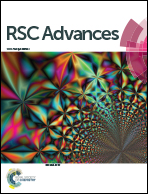Optical properties of biosilicas in rice plants†
Abstract
Although biogenic amorphous silicas (biosilicas) accumulated in rice plants play many important roles, such as enhancing mechanical strength, preventing disease, feeding damage, and encouraging photosynthesis, details of their properties have not been studied with an engineered approach. In the present work, we investigated the optical properties of two kinds of biosilicas in matured rice plants: silicified long cells, called “silica plates”, that cover the surfaces of leaf blades, and fan-shaped silicas aligned inside the blades. The path of light in the biosilicas was analyzed using two-dimensional optical simulation and actual optical experiments. We found that silica plates that have micrometric projections on their surfaces diffuse visible light effectively in the leaf blade, and fan-shaped silicas have a role in guiding light to chloroplasts. Thus, biosilicas would act as a solar diffuser panel and a window for promoting photosynthesis.


 Please wait while we load your content...
Please wait while we load your content...